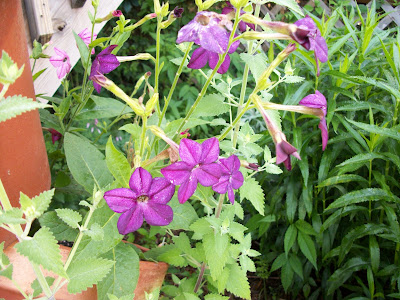The Garden in June
I don't have many annuals in my garden
so I rely on the succession of blooms
from my perennials.
This means that I sometimes need
to fill in here and there with new plants
as I find that there are times with few
plants blooming.
I don't have many annuals in my garden
so I rely on the succession of blooms
from my perennials.
This means that I sometimes need
to fill in here and there with new plants
as I find that there are times with few
plants blooming.
 Last year we went from a cool, wet spring
Last year we went from a cool, wet springdirectly into a hot dry summer.
It was so dry for so long that it became a drought.
Thus, it was pointless to harvest the red onions
I had planted.
So this year the onions are blooming.
What this means for me now
is that I get these pretty blooms
but small onion bulbs.
I am harvesting the onions
and using them quickly as they will not store well.
 This is some sort of wild onion that has popped up
This is some sort of wild onion that has popped upin my garden.
I don't know where it came from,
only that I didn't plant it.
It has a very pronounced onion flavor.
 Nigella is often grown for the seed pods.
Nigella is often grown for the seed pods.These can be cut and used in arrangements.
Dried, they retain their color for months.
 This is the flower of Nigella.
This is the flower of Nigella.The more common color for this plant is the medium blue
in the upper right of the photo.
Nigella reseeds readily,
so I have this plant throughout the garden now.
Nigella does not like to be transplanted.
 Echinacea, or purple coneflower.
Echinacea, or purple coneflower.I started off with a few plants and am now finding
it everywhere.
I gave a few plants away this year.
 Another old-fashioned annual that I love.
Another old-fashioned annual that I love.Cleome, or spider flower.
With luck, these will reseed in the garden so that I
will have them next year as well.
 This is a volunteer in the garden,
This is a volunteer in the garden,but I rather like it, so it is staying.
It is Leonorus cardiaca, or motherwort.
The latin name Leonorus refers to the fact that the
leaves look like a lion's tail.
Historically, motherwort was used for
female problems, thus the common name.
The word "wort" is from the Middle English wyrt
and simply means "plant".
Motherwort is a member of the mint family.
 Lysimachia clethroides, or Gooseneck Loosestrife.
Lysimachia clethroides, or Gooseneck Loosestrife.This plant goes forth and multiples like crazy,
so be prepared to give extra plants away to friends and family
or just throw them away.
 Platycodon, or Balloon Flower.
Platycodon, or Balloon Flower.Three guesses as to why it is called Balloon Flower
and the first two don't count.

 Dianthus, or Pinks.
Dianthus, or Pinks.These are in the carnation family.
This plant has been happily growing in this spot for
several years, despite being quite neglected.



































1 comment:
Looks lovely. We have a lot of the same things.
Post a Comment